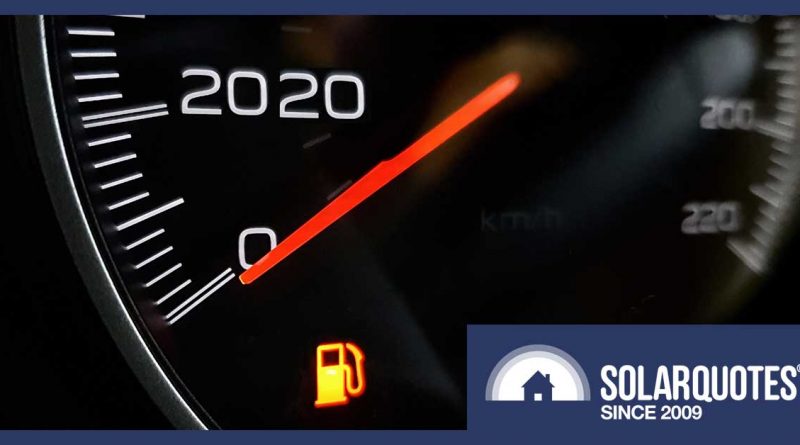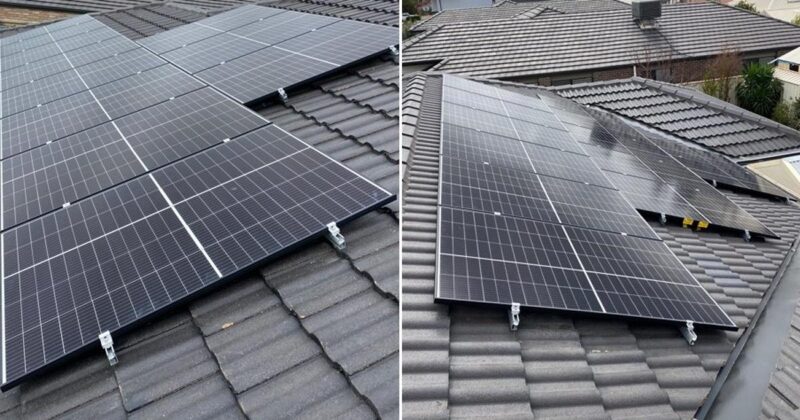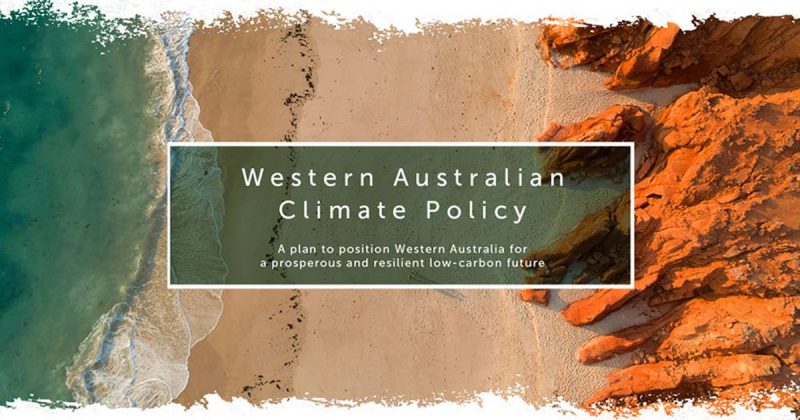2020 In Review: Fossil Fuel Industry Running On Fumes
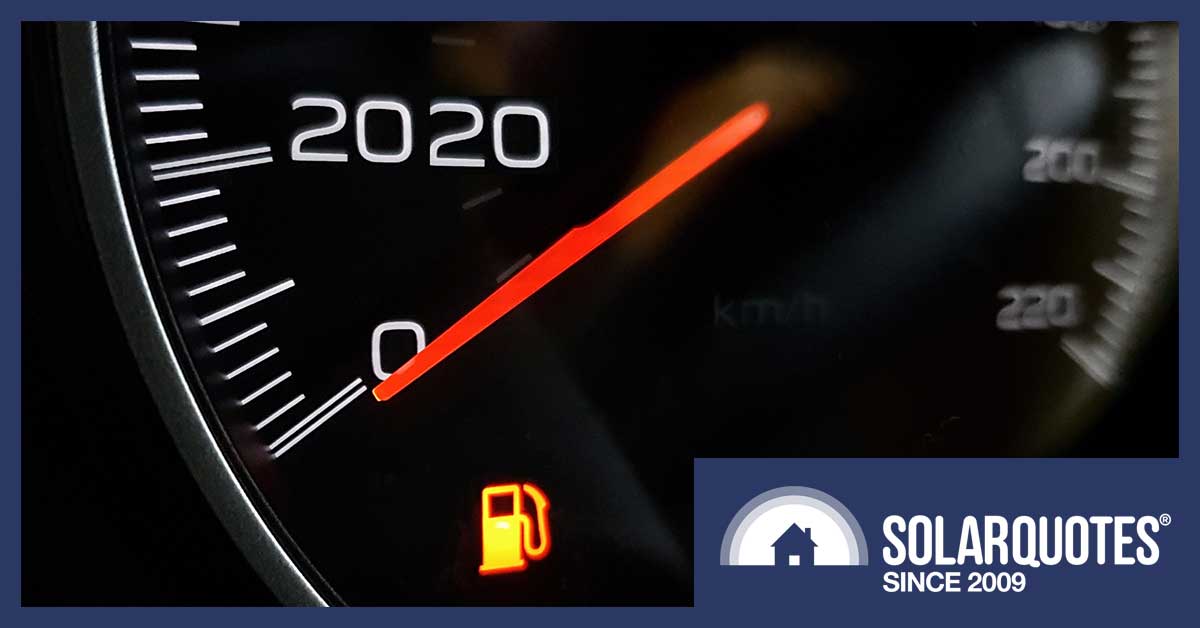
The year 2020 was wonderful except for one little thing, and it’s hard to get littler than a virus. Thank god Australia got off lightly compared to most.
But if you’d rather give credit to those who saved our bacon rather than upper management, you can thank the medical professionals. They refused to let the Government make a dog’s breakfast of our pandemic response.
I know it has become almost mandatory to deride 2020 as an annus horribilis, but if you join me in looking on the bright side of things, I’ll show you how to find joy in this horrible annus. So please don your gay apparel — which in this case should be a festively themed facemask — and join me in clearing coronavirus contaminated corrosion from what I know appears to be the most lacklustre year since disco died.

Under The Dross, 2020 Contained Brilliance That’s Ready To Shine Through.
The baddest of bad news for this year has taken many good people from us. The goodest of good news is there’s an excellent chance we won’t die in the future. And by we, I mean humanity. No – immortality is not yet available. Things are looking up, but not that far up.
Renewables are undeniably cheaper.
The good news is renewable energy — especially solar power — is now cheaper than fossil fuels. And when I say it’s cheaper, I don’t just mean:
- When including the health and environmental costs of fossil fuels.
- When the sun shines, or the wind blows.
- When deciding between building new fossil fuel capacity or new renewable capacity.
I’m saying that a combination of solar and wind generation and energy storage is now cheap enough to drive existing, paid off, fossil fuel power stations out of business. It’s not just cheaper, it’s so much cheaper there is no escape from the revelation, and soon only fools and the mad will deny it.
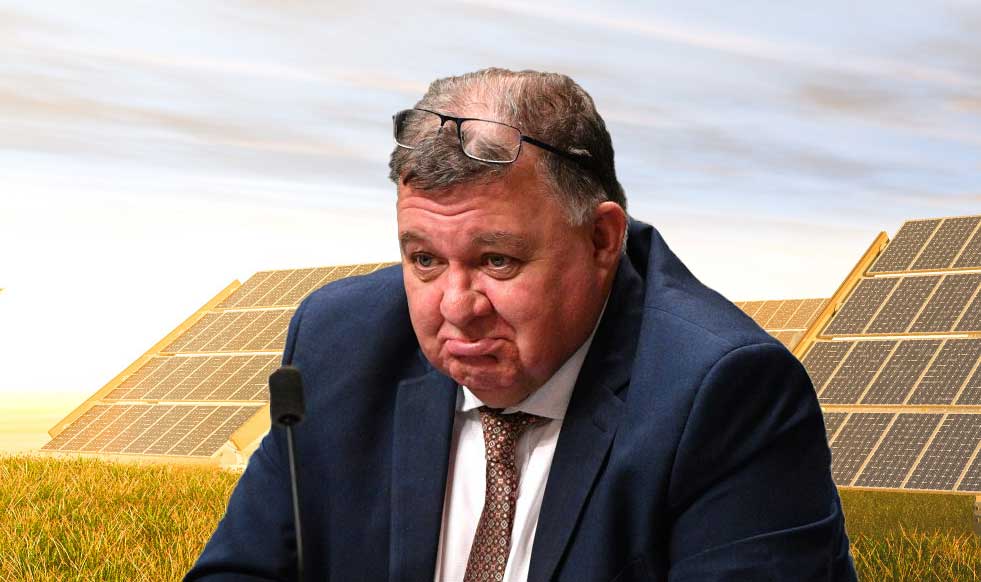
I’m talking about large-scale renewables and energy storage here. Rooftop solar in Australia started paying for itself years ago, although home batteries still don’t pay for themselves under normal circumstances.
Strangely, the rest of the world has mostly ignored Australia’s success with rooftop solar just as they ignored our handling of the Global Financial Crisis, our raising of worker incomes in an English speaking country, and Aussies mostly not dying from a plague.
But giant wind farms, big solar and big batteries are big business and can no longer be ignored.
Much to my chagrin1, this doesn’t mean we can run up to our remaining coal power stations, give them a stiff kick and watch as they crumble into dust. It won’t be quite that easy. But a relatively rapid demise of coal power followed by gas is certain.
But the impending demise of fossil fuel generation isn’t the only good news of the year.
One Year From New Virus To New Vaccine
On December 8th 2019 a resident of Wuhan rocked up to hospital with a disease resembling pneumonia. Just 33 days later, Chinese researchers had determined the genetic sequence of a previously unknown coronavirus and published it on the internet to benefit medical experts worldwide. On the 8th of December 2020, one year after the first known hospitalization for COVID-19, the UK began to vaccinate the most vulnerable. Multiple effective vaccines will soon be available2. While supplies are limited now, billions of doses will be produced before the end of 2021.
While I wasn’t surprised by the vaccine development speed, this was only because I knew how far humanity had progressed with this sort of thing. If COVID-19 had cropped up 10 years ago, everything would be more difficult, and millions would have been cooped up in Melbourne with crap internet. If the virus showed up 50 years ago then… well, it probably would have burned out before spreading far. The roads around Wuhan were absolute rubbish back then, and the virus may never have infected enough humans to mutate into its now highly transmissible form.
When around two-thirds of Australians are immunized, the country may become pandemic proof. But we will likely need to immunize more than that to be on the safe side3 and because “pandemic proof” is not the same as “nobody gets sick”.4

This XKCD comic can be found here. There are other pandemic related ones here and here and here and here and here…
CO2 Emissions Have Passed Their Peak
Global greenhouse gas emissions peaked last year and fell 6.5% in 2020 year thanks to the pandemic:
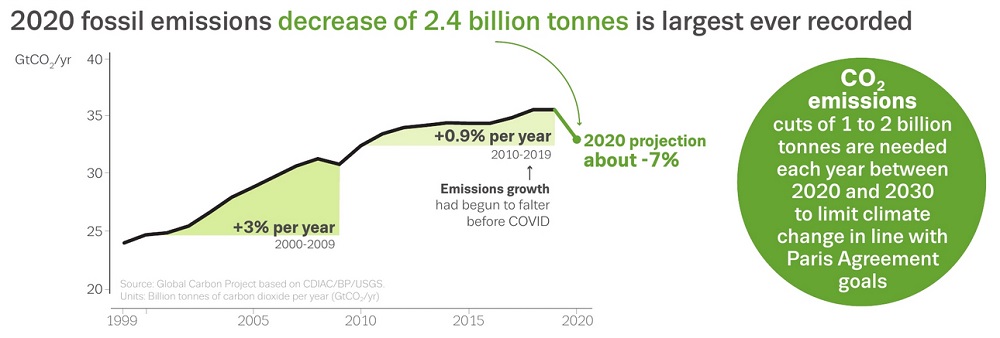
This says about a 7% drop in CO2 emissions, but they are rounding up. Source: Global Carbon Project
Most of this decline is temporary and will disappear once the world economy picks up – but not all of it. I am confident — as in I’m willing to bet money — that world CO2 emissions have passed their peak and will never again reach the level they were in 2019. Renewable energy is stomping the fossil fuel competition and the only car manufacturer to turn a profit this year has been Tesla. I’ve tried a few electric vehicles, and I promise you, they are poised to take the world by storm.

By electrical storm.
A Long Way To Go On Emissions
While passing peak emissions is necessary to keep even one icecap intact, it does mean we’ve only stopped increasing the rate we’re making things worse. We still have to get our emissions down to a safe level, which at the moment looks like it would be a negative amount5.
As you can see from the readings below taken at the Mauna Loa Observatory in Hawaii6 atmospheric CO2 levels rose this year much the same as they did in the previous five:
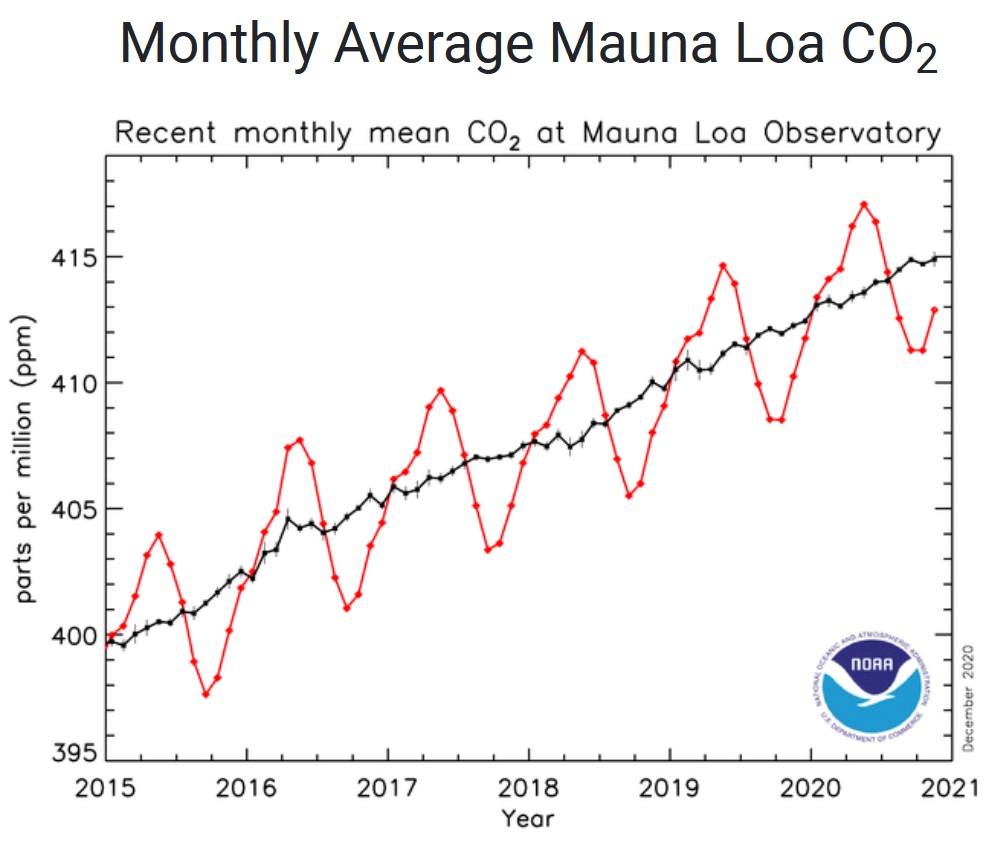
We need to cut civilization’s emissions by at least 80% to stabilize the amount of CO2 in the atmosphere and melt the icecaps more slowly. If we cut emissions by a net 100%, it will allow the oceans and other carbon sinks to draw down a modest portion of the CO2 in the air and keep us from cooking our gooses — as well as all other non-mutant waterfowl.
So while we still have a long way to go, without the recent emissions downturn this November’s figure for atmospheric CO2 parts per million would be even worse:
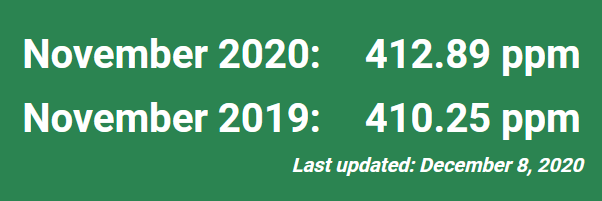
Renewable Price Plunge
The cost of solar has fallen through the floor, and if it keeps going, it may need to be reclassified as geothermal energy as it burrows through the earth’s crust. This graph from Our World in Data shows the cost of solar energy dropping 89% over 10 years and onshore wind energy by 70%:
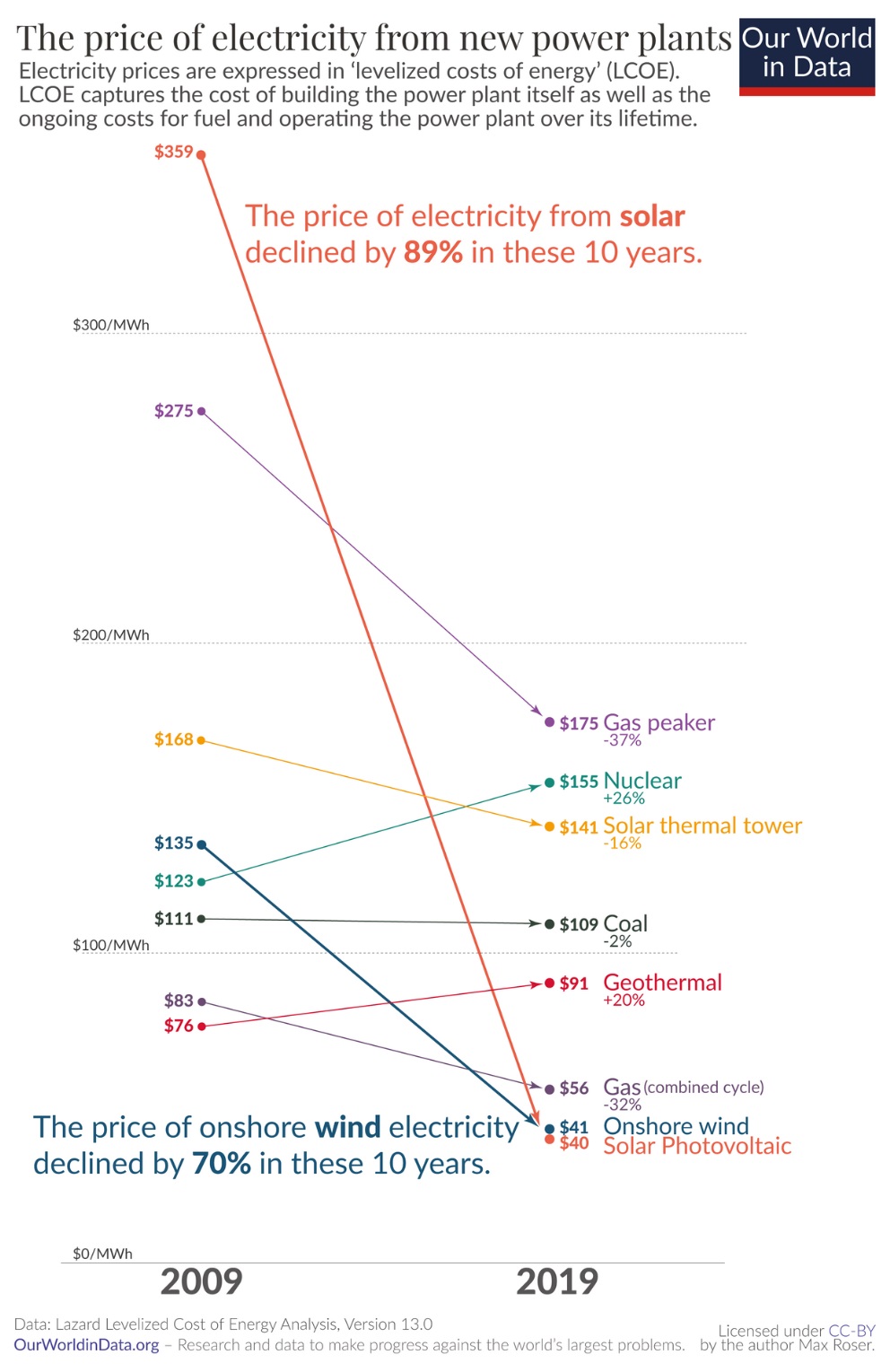
But I’m afraid this graph is misleading because the figures don’t represent real-world prices. In reality, the cost of wind and solar energy is considerably less. The information’s off because it uses Lazard’s estimates for the levelized cost of energy that assume an interest rate of 8%7. While this made sense decades ago, these days a 0% interest rate would be more accurate. The current rock bottom cost of capital makes wind and solar energy generation cheaper as their cost is mostly capital.8 While interest rates may rise after the pandemic, they’re not likely to rise by much. The general trend has been downwards for over 30 years now, and I don’t expect any major change in a hurry.
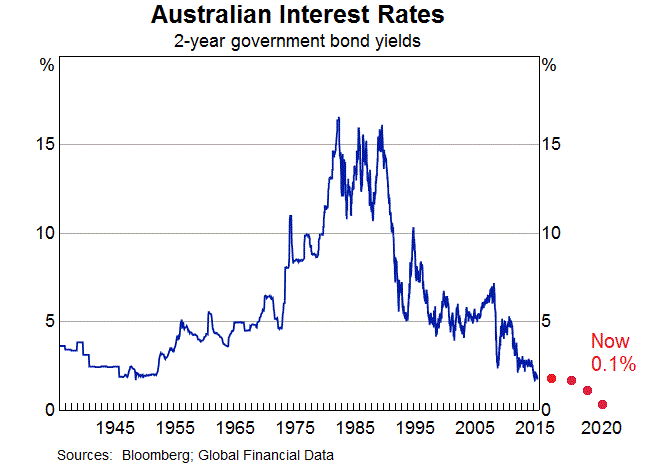
I added the bit in red to make the graph more up to date.
Interest rates ranging from low to nearly non-existent have caused solar to be bid in at impressively low prices worldwide. Here’s what some solar projects are being paid to go ahead in Australian cents per kilowatt-hour at today’s exchange rate9:
Because even the lowest cost, fully paid off, coal power stations generally need to receive an average at least 3 cents per kilowatt-hour to stay in business, the falling cost of solar hardware combined with low-interest rates10 means the world’s remaining coal power stations will soon go under. While gas power stations are likely to stick around a while longer, they’re threatened by the falling cost of energy storage.
Batteries Became Cheaper
One and a half years ago Elon Musk said Tesla would produce battery cells under $132 Australian per kilowatt-hour11 by the end of 2018.
He also promised the cost of cells combined into battery packs would be under $132 per kilowatt-hour before June 2020. But, strangely enough, when these dates rolled around Elon totally failed to point out how he’d been right. This uncharacteristic restraint, combined with the fact Tesla increased Powerwall home battery prices, makes me think he either exaggerated or failed.
Fortunately, Tesla is not the only battery maker in town. We have evidence from China that battery packs used in some electric buses are now under $132 per kilowatt-hour, while the market average for electric vehicle battery packs worldwide is around $180 per kilowatt-hour. By 2023 battery packs are expected to average around $133 per kilowatt-hour.
The low cost of battery storage means renewable energy isn’t just cheaper than fossil fuels when the sun shines, or the wind blows. It’s now cheaper to instead use a combination of solar, wind, and energy storage to meet electricity demand. As one example, if the proposed Goyder South Hybrid Renewable Energy Facility in South Australia goes ahead, it may consist of:
- 600 megawatts of solar panels.
- 173 megawatts of wind turbines, and…
- 1,800 megawatt-hours of battery storage that can supply 900 megawatts of power.
The battery alone could meet over one-quarter of the state’s peak grid electricity demand during a heatwave for two hours.
EVs Ready To Roll
Around 2.3% of vehicles manufactured in 2019 were electric. In 2020 the estimate is 2.5%. While this makes it appear that EVs’ total production increased, they actually fell due to the global pandemic. The percentage figure only increased because other vehicle production fell further. But when it comes to beating the competition, a percentage increase is still a win.
Over half of new cars sold in Norway this year were electric, and among the accursed Dutch, it was 15%. When it comes to EV adoption, Australia is a little behind Norway, but only because we’re so far behind, we lapped the planet.12 But EVs will take off here. Almost everyone with money will soon want one simply because their performance is so much better than comparatively priced internal combustion engine cars. Over time, they’ll become affordable for people who would normally only buy lower cost new cars. While some think current electric cars are too expensive for Australians, the median price of a new passenger vehicle last year was around $60,000, so it’s not as if no one can afford to buy them.
More EVs is useful because they’re energy storage on wheels. While they can supply power to the grid when needed, simply charging them when solar and/or wind output is high helps integrate more renewables into the grid.
Coalition Coal Cock-up
The Federal Coalition has been in power for over seven years. In that time, they have:
- Reduced the Renewable Energy Target
- Axed the carbon price
- Promoted coal mining
- Promoted new coal power stations
- Tried to prevent coal power stations closing
- Worked to ensure the failure of international agreements on emissions.
Back when he was the Treasurer, our current Prime Minister even took a lump of coal to Parliament and waved it around so the other Coalition members would be jealous of what Santa had stuffed in his stocking. The Coalition lives for coal. It’s just the rest of the world that dies for it.
While it is bad for Australia’s economy in the short term, I have to say the Coalition’s long term love-on for coal makes it kind of hilarious they have screwed up so badly that China no longer wants to buy it from us.
Due to current Sino-Australian trade bitchiness, Australian coal exports to the Middle Kingdom are a fraction of what they were.13 While China is suffering from high coal prices and rolling blackouts,14 they prefer to put up with the pain in a pandemic damaged world economy rather than back down. If you’d told me just one year ago the Coalition would make such a colossal coal cock up they’d lose our second largest customer, I would never have believed it.
The coal shortage in China is hastening their transition to renewables while here it’s resulted in the delay and potential cancellation of coal mine expansions. So the government that loves coal has managed to harm Australian coal mining and caused irreparable damage to our largest coal export market.
If we got into this position due to bad luck or because we’d taken some moral stand, that would be one thing, but I’m afraid it was stupidity all the way. Scott Morrison decided to poke a bear when it was in a particularly grumpy mood. Poking a bear when you’re an extra-large curry-flavoured snack in a suit is never a good idea.
Worst of all, Morrison’s motive in making China mad appears solely to have been to get in the good graces of Donald Trump:
- A man who drops allies faster that you drop a Tinder date who turns up with your name carved into their face.
- A politician who caves so easily he can be used to rescue Thai schoolboys.
- A man as effective as Boris Johnson’s hairbrush
- A man more self-serving than a waiter practising in a mirror.
- A man so callous the United States hasn’t had a President whose actions have resulted in more needless deaths since two Presidents ago.
Maybe Morrison thought other countries would have his back, but they are pissed off with Australia’s inaction on climate change and have zero desire to intervene on behalf of coal exports. The Chinese Government clearly did not target coal at random. They are turning the screws to isolate Australia and maximize pain to our economy and embarrassment to the Coalition.
In return for pushing for an inquiry into the origins of the coronavirus that probably would have gone ahead anyway, Scott Morrison received a nice medal from Donald Trump:

The US Order of Merit (Source: Medals of America.)
The US Order of Merit is beautiful and sells for anything up to $500 on eBay.
Fossil Fuels Won’t Die Overnight — But It Will Happen
The days of fossil fuel generation are numbered. The bad news is those numbers are still fairly high. While wind and solar energy generation combined with battery storage will drive coal and then natural gas out of the electricity sector, it’s still going to take time. The good news is we can speed things up through our personal actions.
Not only is Australia a representative democracy, but our culture is also materialistic and individualistic. Pretty much like Chinese culture. This means we can pay to put goddamn solar panels on our roofs if we want. The local grids don’t always have the capacity to export as much clean energy as we’d like, but at least it’s possible to complain to our MPs about this without getting screws turned on us.
Fortunately for us, since big business is all about making bank, it now has no interest in new coal power in Australia and very little interest in new gas or diesel generating capacity. They know there is no money in it, and the future is renewables and energy storage, which will be the case around the world.
At the moment, large scale solar and wind farm construction in Australia is constrained by transmission capacity, and it usually takes at least two years for new lines to be planned, approved, and built. But lower interest rates make new transmission cheaper, and it looks certain grids will have their long-distance transmission capacity beefed up considerably over the next few years. By the time that happens the cost of renewables and storage will have fallen even further. After the Liddell Power Station closes in 2023, Australia’s remaining coal capacity will be lining up for permission to shut down permanently.
While 2020 may have been a pretty crappy year, I think 2021 will be the start of a very optimistic decade.
Footnotes
- Chagrin is a French word meaning “grief”. Also, “smiling Japanese tea”.
- Just found out the cheap to produce Oxford/AstraZeneca vaccine is 95% effective at preventing symptoms and 100% effective in preventing severe COVID-19 in trial participants. Also, a Turkish trial of relatively easy to produce Chinese vaccine found it to be 91% effective, which is additional good news for those looking to vaccinate on a budget.
- It would be nuts not to immunize nearly 100% of the elderly, but we will still need high immunization rates among the young to stop them spreading it.
- Alternatively, we could give most of our vaccine doses to countries where the virus is taking a terrible toll. After all, ’tis the season for giving.
- Fortunately, it doesn’t look like it will be too difficult to remove a modest portion of the CO2 from the atmosphere through a variety of fairly low tech methods, such as growing plants and then doing terrible things to them.
- The fact the observatory is on a volcano is not a problem. I can understand someone wondering if volcanic CO2 emissions affect the readings. Still, anyone who jumps from wondering to saying it is a problem is a double idiot: (1) They didn’t bother to actually check, and… (2) They assumed the people taking the measurements are even dumber than they are.
- According to the note near the bottom of page two of this analysis.
- It also makes coal and nuclear cheaper, but their costs are so high they can’t compete. These two energy sources also don’t play well with solar and wind because they save little money by shutting down during periods of high renewable output.
- Currently, 76 US cents to the Australian dollar.
- While interest rates in Mexico and India are still well above 0% at 4.25% and 4% respectively and Mexico was actually at 7% at the time the solar price I gave was bid in, the low cost of solar panels and inverters plus plenty of sunshine in those locations still makes it cheap.
- $100 US per kilowatt-hour.
- Since we lapped the planet it’s kind of fitting we wound up in Lapland.
- In the 12 months up to November they were 54% what they were in the 12 months before that, but they have been heading down and may be next to nothing now.
- The near abolition of Australian coal imports is not the only contributor to the blackouts, but it is a major one — despite what China’s media says.
Original Source: https://www.solarquotes.com.au/blog/2020-in-review/

